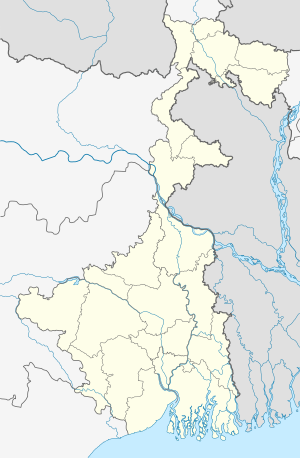Bargorya
Bargorya is a village in the Manbazar II CD block in the Manbazar subdivision of the Purulia district in the state of West Bengal, India.
Bargorya | |
|---|---|
Village | |
 Bargorya Location in West Bengal, India  Bargorya Bargorya (India) | |
| Coordinates: 22°56′08.9″N 86°39′28.9″E | |
| Country | |
| State | West Bengal |
| District | Purulia |
| Population (2011) | |
| • Total | 1,096 |
| Languages | |
| • Official | Bengali, English |
| Time zone | UTC+5:30 (IST) |
| Telephone/STD code | 03253 |
| Lok Sabha constituency | Jhargram |
| Vidhan Sabha constituency | Bandwan |
| Website | purulia |
Geography
 |
| Places in Manbazar subdivision in Purulia district CT: census town, R: rural/ urban centre, H: historical/ religious centre Owing to space constraints in the small map, the actual locations in a larger map may vary slightly |
Location
Bargorya is located at 22°56′08.9″N 86°39′28.9″E.
Area overview
Purulia district forms the lowest step of the Chota Nagpur Plateau. The general scenario is undulating land with scattered hills. Manbazar subdivision, shown in the map alongside, is located in the eastern part of the district. It is an overwhelmingly rural subdivision with 96.32% of the population living in the rural areas and 3.68% living in the urban areas. There are 3 census towns in the subdivision. The map shows the Kangsabati Project Reservoir. The Mukutmanipur Dam is in Bankura district but the upper portion of the reservoir is in Manbazar subdivision. The remnants of old temples and deities are found in the subdivision also, as in other parts of the district. The subdivision has a very high proportion of Scheduled Castes and Scheduled Tribes. Bandwan CD block has 51.86% ST population, Manbazar II CD block has 48.97% ST population. Manbazar I CD block has 22.03% ST and 22.44% SC. Puncha CD block has 24.74% ST and 14.54 SC. [1][2][3][4]Writing in 1911, H. Coupland, ICS, speaks of the aboriginal races largely predominating in the old Manbhum district. He particularly mentions the Kurmis, Santhals, Bhumij and Bauri.[5]
Note: The map alongside presents some of the notable locations in the subdivision. All places marked in the map are linked in the larger full screen map.
Demographics
According to the 2011 Census of India, Bargorya had a total population of 1,096 of which 557 (51%) were males and 539 (49%) were females. There were 144 persons in the age range of 0-6 years. The total number of literate persons in Bargorya was 676 (71.01% of the population over 6 years).[6]
Civic administration
CD block HQ
The headquarters of the Manbazar II CD block are located at Boro. The District Census Handbook shows, in its map, Bargorya as headquarters of Manbazar II CD Block, but the website of Manabazar II Block Development Officer mentions Boro as headquarters of the block. The latter appears to be more authentic. District Census Handbooks are the only source showing the headquarters of all CD blocks throughout West Bengal.[7][8]
Transport
Bargorya is on the road from Kuilapal, on State Highway 5 (West Bengal), to Ladda, by the side of Mukutmanipur reservoir.[9]
References
- Houlton, Sir John, Bihar, the Heart of India, 1949, p. 170, Orient Longmans Ltd.
- "District Statistical Handbook 2014 Purulia". Tables 2.1, 2.2. Department of Planning and Statistics, Government of West Bengal. Archived from the original on 21 January 2019. Retrieved 12 January 2020.
- "CD block Wise Primary Census Abstract Data(PCA)". 2011 census: West Bengal – District-wise CD blocks. Registrar General and Census Commissioner, India. Retrieved 16 January 2020.
- "Travel and Tourism : Purulia". The Official Website of Purulia District.
- "Bengal District Gazetteers – Manbhum by H. Coupland". Page 76: Manbhum, Castes and Tribes. University of California, San Diego. Retrieved 10 February 2020.
- "2011 Census – Primary Census Abstract Data Tables". West Bengal – District-wise. Registrar General and Census Commissioner, India. Retrieved 2 December 2016.
- "District Census Handbook: Puruliya" (PDF). Map of District Puruliya with CD Block HQs and Police Stations (on the fifth page). Directorate of Census Operations, West Bengal, 2011. Retrieved 2 December 2016.
- "Manbazar II Development Block". BDO, Manbazar II. Archived from the original on 20 December 2016. Retrieved 2 December 2016.
- Google maps